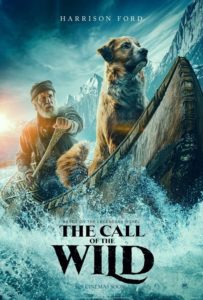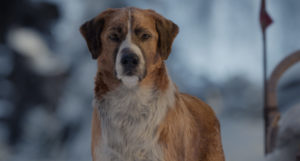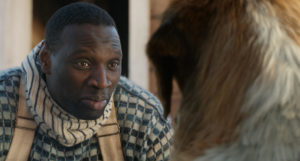Film Review: “The Call of the Wild” Tells an Inspiring Dog’s Tale, but Bites off a Bit More Than It Can Chew
Written by: Matt Patti | February 20th, 2020

The Call of the Wild (Chris Sanders, 2020) 2½ out of 4 stars.
I read Jack London’s acclaimed novel The Call of the Wild back in middle school and remember it as an interesting, heartwarming book without remembering too many details of the plot. What I do recall, however, is that many different events happened in the book and it was a very long journey. Even though the book isn’t very long, page-wise, it took me a while to read it, as it was a tale of large scope told over a long period of time. I was naturally excited to see this film adaptation due to my fond nostalgic memories of reading this as a kid. However, I was a bit concerned about how they would fit so much information into a 1-hour-and-40-minute film.
The Call of the Wild takes place in the wild Alaskan Yukon of the 1890s. We follow Buck, a large but loveable St. Bernard who is kidnapped from his California home and taken to the Yukon to be sold, the territory bustling with activity due to the discovery of gold. Buck soon finds himself a member of a sled-dog team and has to learn how to adapt to the cold, harsh environment to survive. He also meets old-timer John Thornton (Harrison Ford, Blade Runner 2049), who takes a special interest in this very special dog.

Throughout the first 30-40 minutes of the film, my fears about cramming in too much material in a short amount of time came true. Buck’s journey is told at a breakneck pace with a bit too much narration (complete with quotes from the book), not giving the audience enough time to digest where Buck is and what he is doing. It is an entertaining and brisk start, but one that doesn’t give us enough time to catch our breath, and is overloaded with exposition. Events are glossed over and obstacles are a bit too easy for Buck to overcome, which is surely done to keep the film moving. Fortunately, the film slows down midway through the second act, and that’s when it becomes a much more enjoyable, interesting story. Harrison Ford delivers a heartfelt performance as Thornton and is great in every second he’s on screen, which unfortunately isn’t as much as I’d have liked it to be.
The technical elements of The Call of the Wild are much more impressive than I imagined. Each dog and animal is animated in such great detail as to give a very realistic appearance, yet still retain emotional facial expressions on their faces. The scenery of the Alaskan Yukon is superbly well done, with the mountains, ice, rivers and caves looking majestic in both intimate close-ups and stunning wide shots. The score is also very well done, adding a sense of adventure as well as some deep, emotional pieces.

Overall, even though the movie brushes past so much in its first act through to the middle of the second act, The Call of the Wild still manages to be a touching and intriguing film that captures much of the book’s spirit and adds in amazing visuals and technical work. I only wish the film were longer, which I don’t say about many films, so that the details of the first act could be drawn out a bit and we wouldn’t be rushing through things. The filmmakers certainly could have made it over two hours, but chose to stick to its 100 minute runtime. I feel like there’s a better version of this film left somewhere on the cutting-room floor. Still, this heartwarming and entertaining story should please most audiences, even if it left this writer wanting a bit more.

